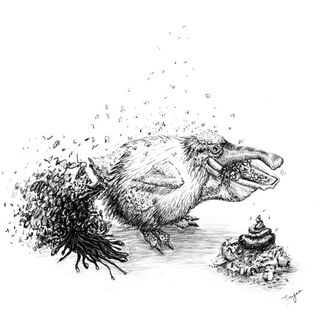Garbichug Revolters
More actions

Garbichug Revolters are flightless avian monsters known to be pests.
Appearance edit edit source
A Garbichug Revolter looks like a giant mutated duck. It can be four to six feet tall. It has teeth in its bill, and a ragged plumage of filthy feathers.[1] Their skin looks moldy or slightly putrid.[2]
Ecology edit edit source
Habitat edit edit source
Garbichug Revolters are native to Rhir. They've spread to every other continents because they were able to swim.[1] They can survive in nearly any habitat, and are known to live in large sewers.[2]
Diet edit edit source
They will eat almost anything, including garbage, excrement, and sewer waste. They are willing to eat poisonous food.
Behavior edit edit source
Garbichug Revolters are aggressive, cowardly animals. They will attack anything they think is weaker than them. They run away from any threat.[2]
Powers and Abilities edit edit source
They are rated as a Bronze-rank threat. They are smart enough to dodge arrows, and are highly resistant to poison, diseases, acid and decay. Extreme spiciness doesn't affect them. They use excrement and regurgitation as self-defense weapons, and smell horrible.[1][2] They are so filthy that using a healing potion after being attacked by one becomes dangerous due to a high risk of infection, and any alchemical ingredient they get into is considered fouled due to the contamination they introduce.[3]
Almost no other animals save themselves will eat them, and their corpse doesn't decompose.[2] Instead, when they die, their bodies start to morph into several juvenile Garbichug Revolters. The filth they eat serves as fuel for this process, which is also why Plague Spells shouldn't be used on them. Burning their corpse is risky, as there is a chance it could cause the body to explode or produce toxic gas. Yet disposing of the bodies may still be necessary despite this due to their method of reproduction.[3]
Trivia edit edit source
- The Rihal Imperium cultivated them as war animals, which earned them international censure.[1] They attempted to use them on the Putrid One, who made them multiply in response. They proceeded to spread several minor plagues.[3]
- They were discovered over thirty thousand years ago.[1]
- Their parts are considered worthless to alchemists.[3]